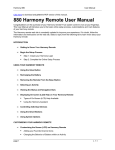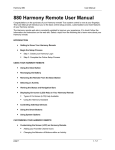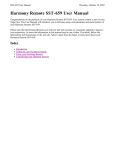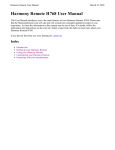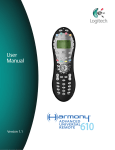Download Harmony Remote User Manual
Transcript
Harmony Remote User Manual 600 Series Congratulations on the purchase of your Harmony remote! True system control is now at your fingertips. This User Manual will introduce you to the basic setup, customizations and main features of your Harmony remote. The Harmony remote web site and web wizards are constantly updated to improve your experience. At times the information in this manual may be out of date. If in doubt, follow the information and instructions on the web site. Select a topic from the following list to learn more about your Harmony remote: INTRODUCTION • Getting to Know Your Harmony Remote SETTING UP YOUR HARMONY REMOTE • Before You Begin the Online Setup Process ! Step 1: Unpack and prepare the remote. ! Step 2: Complete the Entertainment Device Worksheet ! Step 3: Install the Harmony Software • Begin the Setup Process ! Step 1: Create your Harmony Login ! Step 2: Complete the Online Setup Process ! Step 3: Synchronize Your Harmony Remote USING YOUR HARMONY REMOTE • Selecting an Activity • Switching Between Activities • Resynchronizing Your Harmony Remote • Using Sound and Picture Modes in an Activity ! Sound Mode ! Picture Mode • Using Device Mode CUSTOMIZING YOUR HARMONY REMOTE • Customizing the Activity Buttons • Changing the Behavior of Buttons within an Activity ! To change the behavior of buttons: ! To change the behavior of a button for an Activity: ! To set a button to send a command to more than one device at a time: • Adding Custom Labeled Buttons ! To add custom-labeled buttons: ! To add a custom-labeled button for an Activity: ! Add a custom-labeled button to send a command to more than one device at a time: • Teaching Infrared (IR) Commands ! Using the Infrared Sensor ! Naming an Infrared Command ADDITIONAL HELP ! Finding Answers to Your Questions ! Troubleshooting Your Harmony Remote Introduction The Harmony remote is an Internet-powered universal remote control. Your Harmony remote can control most devices that understand infrared (IR) signals. The configuration of your Harmony remote is simple: • Answer web wizard questions to create your own personal Harmony remote configuration. • The web wizard allow you to describe the entertainment devices you want to control, how they are set up, and your preferences for controlling them. • If one of your devices is not in the Harmony Remote web site's database, the web wizard will learn about your device and add it to your configuration. At the end of the setup process, you will have your own configuration loaded in your Harmony remote and your own personal Harmony Member home page. Return to your Harmony home page as often as you like to: • customize any of your Harmony remote’s features • add new entertainment devices • add new features such as interactive television listings or CD Jukebox Media Listings Getting to Know Your Harmony Remote Many of the Harmony remote's buttons are standard remote buttons. However, there are buttons and other hardware that may not be so familiar to you. The extra buttons and hardware give you access to the special features of the Harmony Remote. 688 628 • USB Connector: Downloads your configuration from the Harmony web site. • Status Light: Illuminates when the Harmony remote is sending commands. • OFF: Turns all devices off with one button press. • HELP: Asks you simple questions so that your Harmony remote can fix problems you are having with an activity. • Activity Buttons: Select an activity and the Harmony remote will set up your entertainment system. • Custom Buttons: Use the buttons at the side of the display to select the corresponding command. Use the NEXT button to display more commands. • LCD: Displays help, infrared (IR) commands and media listings. • Device: Lists all your devices in the LCD, and allows you to select and fully control any device directly. • Guide (Media): Gives access to media listings such as the Harmony Electronic Program Guide (EPG) or CD Jukebox Media Listings. Note: There is an additional charge for these features. Call the Harmony Support Team toll free at 1-866291-1505 to find out how to get these additional features. • Next: Shows more choices in the LCD. • Sound: Controls special sound features. • Picture: Controls special picture features. • Glow: Backlight glow. • Infrared Learning Port: Use this port to teach the Harmony remote commands from your original remote. 655 659 676 Setting up Your Harmony Remote This section describes the setup process for the Harmony remote. The setup process has been broken down into two stages: the first stage requires you to complete some simple steps to prepare for the setup process; the second stage requires you to begin the setup process online. Much of the setup process is completed online. Before You Begin the Online Setup Process Step 1: Unpack and prepare the remote. a. Ensure you have received the following items: • 1 Harmony remote • 1 USB Cable • 4 AAA batteries • 1 Software Installation CD b. Open the battery compartment on the underside of your Harmony remote. Insert the four AAA batteries as indicated on the bottom of the battery compartment. Close the battery compartment. Note: Be sure to slide on/off the cover of the battery compartment. Step 2: Complete the Entertainment Device Worksheet Fill out the Device Worksheet with the details of the entertainment devices you would like to have the Harmony remote control. Once you have completed all the information, take your current remote controls and the worksheet to your computer. Step 3: Install the Harmony Software Windows Users The minimum recommended Windows™ system configuration requirements are: • • • • IBM compatible PC with USB plug and play support Microsoft Windows 98SE/Me/2000/XP operating system 10 MB free hard drive space Internet connection (dial-up, cable, LAN, etc.) Installation Steps a. Connect one end of the provided cable to the USB port on your computer and the other end to your Harmony remote. b. The Harmony remote will automatically be detected and USB Human Interface Device drivers installed. For some versions of Windows you may be prompted to insert your Windows software CD. Insert your Windows software CD into the computer’s CD-ROM drive when asked to do so, then follow the online instructions. c. Log in to the Internet using the account and password provided by your Internet Service Provider (ISP). d. Insert the Harmony Client Software CD into the CD-ROM drive of your computer. After 10 seconds the installation program will automatically start. If the installation does not automatically start, click the Start menu on the taskbar and then click Run. Type D:\Windows\setup.exe (where D: is the designation of the CD-ROM drive). e. Follow the online instructions to complete the software installation. f. If your computer reboots at the end of the software installation process, go to step 1 in Begin the Setup Process. g. After the software is installed, a web browser window will automatically open and take you to the Harmony remote Software page. Go to step 1 in Begin the Setup Process. Mac Users The minimum recommended Macintosh system configuration requirements are: • • • • Mac with USB plug and play support Mac OS X operating system 10 MB free hard drive space Internet connection (e.g. dial-up, cable, LAN) Installation Steps a. b. c. d. e. f. Insert the Harmony Client Software CD into the CD-ROM drive of your computer. After a few seconds, a CD-ROM icon will appear on your desktop. Double-click the CD-ROM icon to view the contents of the CD-ROM. Double-click the Mac folder and then click the Harmony remote Software.mpkg icon. Follow the online instructions to complete the software installation. After the software installation completes, the Harmony remote application will automatically start and the Harmony icon will be displayed in the Dock. If the application does not automatically start, then use Finder to open the Applications folder and double-click the Harmony remote application. g. Click Harmony Remote from the menu bar and then click Preferences. In the Preferences dialog box, set the Download Folder to match the downloads folder for your Safari web browser. To check the Downloads folder for Safari, open the web browser and select Safari/Preferences/General/Save. h. In the Harmony remote Preferences dialog box, ensure the Watch download folder and Cleanup downloaded files are selected. Note: If you have not set your download directory previously, you will not be able to select the Watch download folder option. i. Connect one end of the provided cable to the USB port on your computer and the other end to your Harmony remote. j. Log in to the Internet using the account and password provided by your Internet Service Provider (ISP). Go to step 1 in Begin the Setup Process. Begin the Setup Process Step 1: Create your Harmony Login If the Harmony Remote web site is not automatically launched, go to the Harmony Remote web site and create an account. Step 2: Complete the Online Setup Process Once you have created your Harmony login, the online setup process begins. You will be directed by a web wizard, which will guide you through a series of question-and-answer steps to complete each of the 5 main steps of the online setup process: 1. Identification: Requires you to create a login on our Member web site. 2. Check Connection: Ensures your computer and your Harmony remote are communicating properly. 3. Set up Devices: Helps you set up a description of your personal audio-visual system. 4. Set up activities: Helps you set up a description of the connections for devices that allow you to perform activities (e.g. Watch Television Activity). 5. Update Remote: Updates your remote with your personal configuration. The Harmony remote provides you with several features to guide you through the setup and customization process: Tool Location Description Example Online web wizards Harmony web site Provides instructional Adding a Device help to guide the user through a series of question-and-answer steps to accomplish a task. FAQs (Frequently- Harmony web site A searchable list of How do I change Asked Questions) customer questions, my Login ID or with answers password? provided by Harmony's support center. Help link Harmony web site Provides specific online help for the page you are on. Tool Help button Location Harmony remote Description Asks you simple questions so the Harmony remote can automatically fix problems you are having with an activity. Example See Getting to Know Your Remote. Step 3: Synchronize Your Harmony Remote After your Harmony remote has been programmed for the first time you must synchronize it with your entertainment devices. Complete the following procedure so the Harmony remote can learn what devices are on and off, and to what inputs the devices are set. You will only have to do this the first time you try an activity. The Harmony remote will remember these settings and will control all of your entertainment devices for you. 1. Turn off all your entertainment devices manually or using the original remote controls. 2. Use the Activity buttons on your Harmony remote to choose an activity you would like to try. 3. If your Harmony remote did not turn on the correct devices for the activity, or if an input or setting is not correct (e.g. you do not see a picture on your TV or do not hear sound) press the HELP button on your Harmony remote. Answer the questions on the remote's LCD by selecting Yes or No. This will synchronize the Harmony remote with your entertainment devices. 4. Press the Harmony remote's OFF button to turn off your entertainment system. 5. Repeat steps 2 to 4 to try other activities. 6. After you have tried each activity (and used HELP, if necessary), if your Harmony remote is not controlling your entertainment system as you expect, return to your Harmony home page. Click Troubleshoot to start the Troubleshooter web wizard, which will help you find the problem and make the necessary changes to get all of your activities working correctly. Using Your Harmony Remote Please read this section before using your Harmony remote for the first time. Selecting an Activity The Harmony remote gives you dedicated buttons for selecting activities. • Press any one of the Activity buttons to jump directly to your favorite activities, or press the More Activities button to display other activities in the LCD. Select the activity you want by pressing the adjacent button. • Since every home has different entertainment devices, your activities will be unique--your Harmony will let you choose the activities that are relevant to you. • As soon as you select an activity, the Harmony remote will send all the appropriate commands to your entertainment system so that it is configured for that activity. For example, in a Watch Television Activity, if you have a television and a satellite receiver, the Harmony remote will turn on your television, turn on your satellite receiver, and set your television to the correct input. Switching Between Activities To change to a different activity: 1. Press any one of the Activity buttons to jump directly to one of your favorite activities, or press the More Activities button to see other activities in the LCD. 2. Select the activity you want to switch to by pressing the button next to it, or press More Activities. Resynchronizing Your Harmony Remote From time to time when you select an activity, the activity may not work. This can happen when the Harmony remote sends many infrared commands to set up all your devices for an activity, but one or more devices are not receiving some commands. The Harmony remote is then "out of sync" with your devices (e.g. it thinks one of your devices is on, but it is turned off). Some of the reasons the Harmony remote can become "out of sync" with your system are: • Someone walks between the Harmony remote and your entertainment system while the status light is on. • You point your Harmony remote away from your system while the status light is on. • There is an object blocking the line-of-sight between your Harmony remote and the system. • You are very far away from your entertainment system. Before resynchronizing, ensure the cause of the problem has been addressed. For example, remove all obstructions so that the entertainment devices can receive the infrared commands from the Harmony remote. Note: If your devices are no longer responding consistently to your Harmony remote, but were doing so before, you may need to replace the remote's batteries. To resynchronize: 1. Press the Help button. The Harmony remote will resend the appropriate commands to your entertainment devices and then ask you a series of questions such as "Is the Television On?" and "Is the Stereo Receiver set to the DVD input?" 2. Answer the questions on your LCD by selecting Yes or No. If you answer "No" to any question the Harmony remote will resend the necessary command and ask you the same question again. When you are done, the Harmony remote will be "in sync" with your devices again. Using Sound and Picture Modes in an Activity Once you have selected an activity, the functionality of each button on your Harmony remote is automatically configured for that activity. Additionally, the Custom Buttons and LCD will give you access to other commands for that activity, which cannot be set to the standard buttons. This is known as the Activity mode. Within each activity you can change how the Harmony remote behaves by switching into one of 3 alternative modes: Sound Mode Sound mode focuses on controlling the sound features of the relevant device you have chosen to control your sound (e.g. Stereo Receiver). When you are in any activity, press the SOUND button to switch to this mode. Once in Sound mode, the Harmony remote will only control sound features. For example, if you have chosen your Stereo Receiver to control the sound in your Watch a DVD Activity, the Sound mode will change the Harmony remote buttons to control the Stereo Receiver as completely as possible. In the LCD you will see commands such as Surround Field or Bass+. Press the SOUND button or appropriate Activity button to return to Activity mode. Picture Mode Picture mode focuses on controlling the picture features of the device you have chosen to view your pictures (e.g. TV or Projector). When you are in any activity, press the PICTURE button to switch into this mode. Once in Picture mode, the Harmony remote will only control picture features. For example, if you have chosen your Projector to display the video in your Watch a DVD Activity, the Picture mode will change the Harmony remote buttons to control the Projector as completely as possible. In the LCD you will see commands such as Aspect or Picture Adjust. Press the PICTURE button or appropriate Activity button to return to Activity mode. Using Device Mode Device mode gives you access to all the possible commands for each device included in your Harmony remote configuration. You should never need to use Device mode during normal use of your Harmony. This mode should only be used to send a specific command to a specific device. You can eliminate the use of Device mode by customizing your activities. For example, you can put commands on the LCD or customize specific buttons for the commands. See Customizing Your Harmony Remote. At any time, press the DEVICE button to switch into this mode. Once in Device mode, the Harmony remote will display a list of all the devices you have in your configuration. Select a device from the list and the Harmony remote will only control the device features. For example, if you choose Television as the device, the number, volume and channel buttons will all control your television. Press the DEVICE button or appropriate Activity button to return to Activity mode. Customizing Your Harmony Remote All customization of your Harmony remote is done from your Harmony home page. • To add or remove an activity, click Add an Activity or Remove an Activity. • To change an activity you have already set up, click Customize next to the Activity icon, and then click the appropriate option. • To add or remove entertainment devices, click Add a Device or Remove a Device. • To change a device you have already set up, click More Options next to a device icon, and then click the appropriate option. • To customize an activity, click Customize next to an activity icon, and then click the appropriate option. • To change the names of activities click Customize link next to the Activity icon, and then click Rename activity name. • To have more than one activity of a given type (e.g. If you have both a cable converter and a satellite receiver, you can add a second Watch Television Activity) click Add an Activity. When you're done, rename the activities to help you distinguish between them (e.g. For the Watch Television Activity you could rename one "Watch Television" to "Watch Cable" and the other to "Watch Satellite".) Customizing the Activity Buttons The Harmony remote gives you dedicated buttons for selecting activities. The Harmony remote will automatically set these buttons so you can start each of your activities. However, you can choose the activity you want to start by pressing any one of the Activity buttons. To customize your Activity buttons, go to your Harmony home page and click Customize Activity Buttons. Click the label for the button you want to change and then click the activity that you want to start when the button is pressed on the remote. Any activities not set to a specific button will automatically be located under the More Activities button. 628 / 655 / 659 688 676 Changing the Behavior of Buttons within an Activity When you select an activity, the Harmony remote will: • turn on all the correct entertainment devices • set their inputs correctly • set up its buttons to control the activity Based on our knowledge of how each of your devices is controlled, the Harmony remote will make its best effort to match all the buttons you need to control an activity. However, there may be some commands you want to add to buttons or display on the LCD. Commands can be added to buttons quickly and easily by customizing any activity to change the behavior of buttons. To change the behavior of buttons: 1. Go to your Harmony home page. 2. Click Customize next to the appropriate activity 3. Click Change the Behavior of Buttons. The first page you see can be used to change the behavior of buttons in your default or Activity mode. This page displays the: • buttons that have a command associated with them • device being controlled • command being sent to the device To change the behavior of a button for an Activity: 1. Select a command from the drop-down list in the appropriate device column, next to the name of the button you want to set. 2. Click Picture or Sound to view and change the behavior of buttons within the Sound or Picture mode of this activity. 3. Click Save. To set a button to send a command to more than one device at a time: 1. Select a command from the drop-down list in each of the required device columns next to the name of the button that you want to set. Adding Custom Labeled Buttons You can also add any number of custom-labeled buttons to an activity. To add custom-labeled buttons: 1. Go to your Harmony home page. 2. Click Customize next to the appropriate activity. 3. Click Change the Behavior of Buttons. To add a custom-labeled button for an Activity: 1. Type a the label you would like to appear on the LCD. 2. Select a command from the drop-down list in the appropriate device column, next to the name of the button you want to set. 3. Click Picture or Sound to view and add custom buttons within the Sound or Picture mode of this activity. 4. Click Save. Custom-labeled buttons appear in the LCD (from left to right, top to bottom). Add a custom-labeled button to send a command to more than one device at a time: 1. Select a command from the drop-down list in each of the required device columns next to the name of the button you want to set. 2. Add as many custom-labeled buttons as you like. Click More Custom Labels to add labels one at a time. 3. When you update your Harmony remote, click NEXT to view all of your custom-labeled buttons a page at a time. Teaching Infrared (IR) Commands The Harmony remote can learn infrared commands from other remote controls, and should only be used in situations where the Harmony Remote web site's infrared database does not already contain an infrared command you would like to use. Determine the device you would like to send the infrared command to: 1. Click More Options next to the Device icon. 2. Click Learn infrared commands. Using the Infrared Sensor The Harmony remote has an infrared sensor at the end opposite to the USB connector. The Harmony remote uses this sensor to learn commands from original device remotes. The following steps outline what happens when you press a button on your original remote control: 1. The infrared sensor on the Harmony remote learns the infrared signal. 2. The Harmony remote uploads it via the USB cable (and your computer's internet connection) to the Harmony Remote web site. 3. The web site will try to find a matching pattern for the infrared signal. 4. If no pattern is found, the signal will be stored as-is in its original format. 5. If a pattern is found, the Harmony Remote web site converts the signal into a format for convenient storage. Either way, the signal is then available for you to assign to a button on your Harmony Remote. Naming an Infrared Command When you teach an infrared command to the Harmony Remote, give the command a name. This way you can refer to this command by name in various locations on the web site. It is best to use the default names listed on the Language page on the web site because the web wizards can perform automatic button function assignments for you. For example, if you teach the volume button infrared commands from your original remote control, name them "VolumeUp" and "VolumeDown" (i.e. with no space, and capitalization as shown). The web wizards look for commands with these names to automatically assign them to the volume up and down buttons on the Harmony remote. Naming Conventions When naming a command for which there is no default name on the Language page, use the following naming conventions to make button assignment and sharing infrared commands easier: • Do not use spaces or other special characters such as /, & or * in the name. • Capitalize the start of words (e.g. NextDisc, ModeDigital). • Start the command name with its main function (e.g. VolumeRearUp, VolumeRearDown, VolumeFrontUp, VolumeFrontDown). This helps group related commands in lists. • For infrared commands that select inputs (e.g. on a stereo receiver), start with the prefix "Input". Do not name the input based on what you have connected to your device, rather name it based on what it is called on the front of the device, or on the remote control (e.g. InputAux, InputVideo1, InputTape, InputDVD, InputVCR). Additional Help The Harmony remote provides you with several features to assist you with: • finding answers to your questions quickly and easily • troubleshooting the setup and customization process Finding Answers to Your Questions The help you find answers to your questions quickly and easily, consult any of the following tools: Tool Location Description Search Harmony web site Keyword search. FAQs (Frequently- Harmony web site A searchable list of Asked Questions) customer questions with answers provided by Harmony's support center. User Manual Harmony web site The User Manual (available in print explains the concept and online formats) of your Harmony Remote and provides information about configuring and using the remote. Help link Harmony web site Provides specific online help for the page you are on (e.g. entering information in fields on the page). Troubleshooting Your Harmony Remote In addition to the tools listed under Finding Answers to Your Questions, you can use the following tool to troubleshoot your Harmony remote: Tool Location Description Example Troubleshooter Harmony web site A web wizard that Not applicable. helps you diagnose and resolve the problem you are having. If you cannot find the answer to your question(s) or troubleshoot your problem(s), contact your Harmony Support Team at 1-866-291-1505 (Monday through Friday 9 A.M. to 10 P.M., Saturday and Sunday 12 P.M. to 6 P.M. Eastern Standard Time).


















